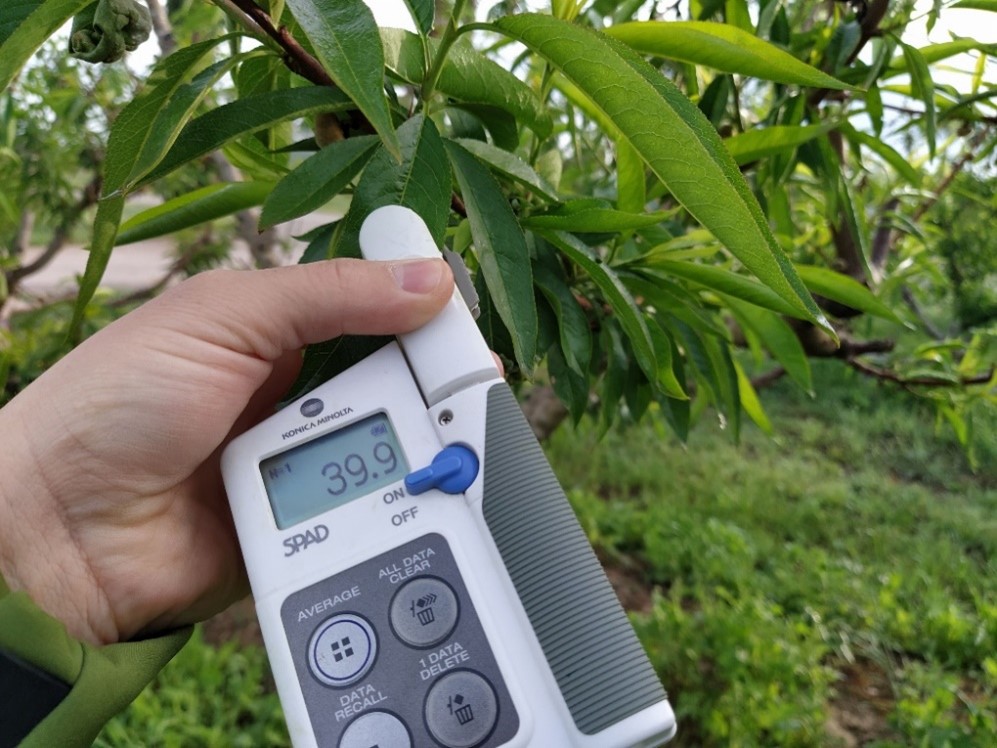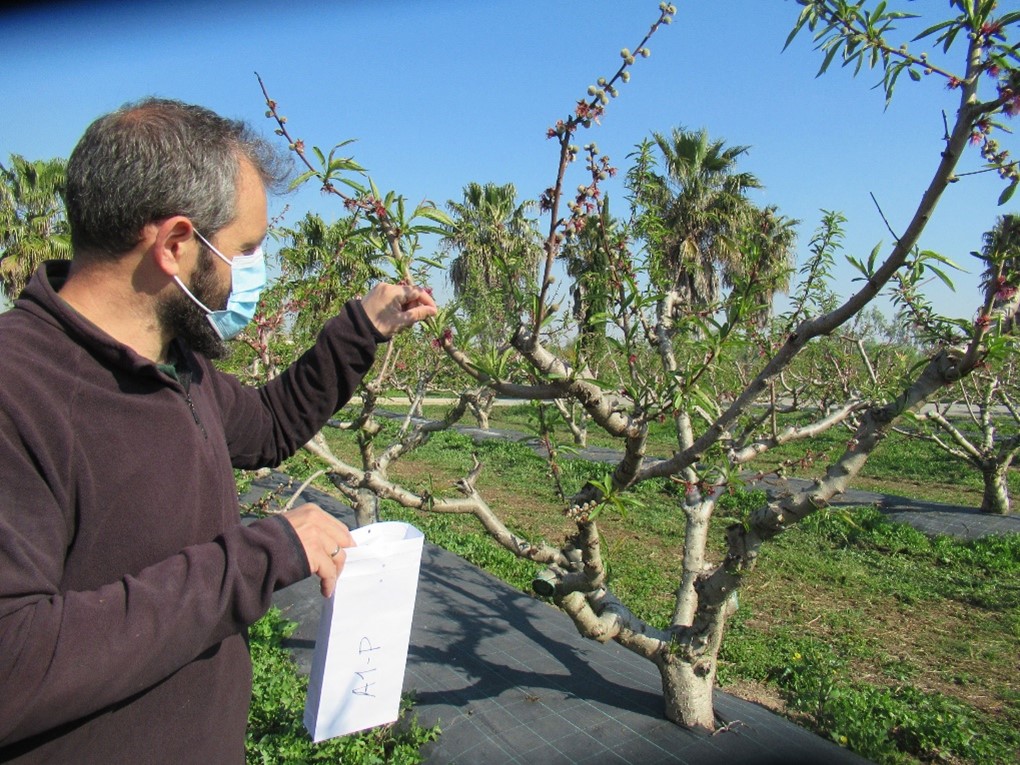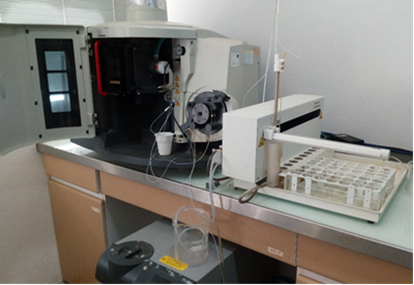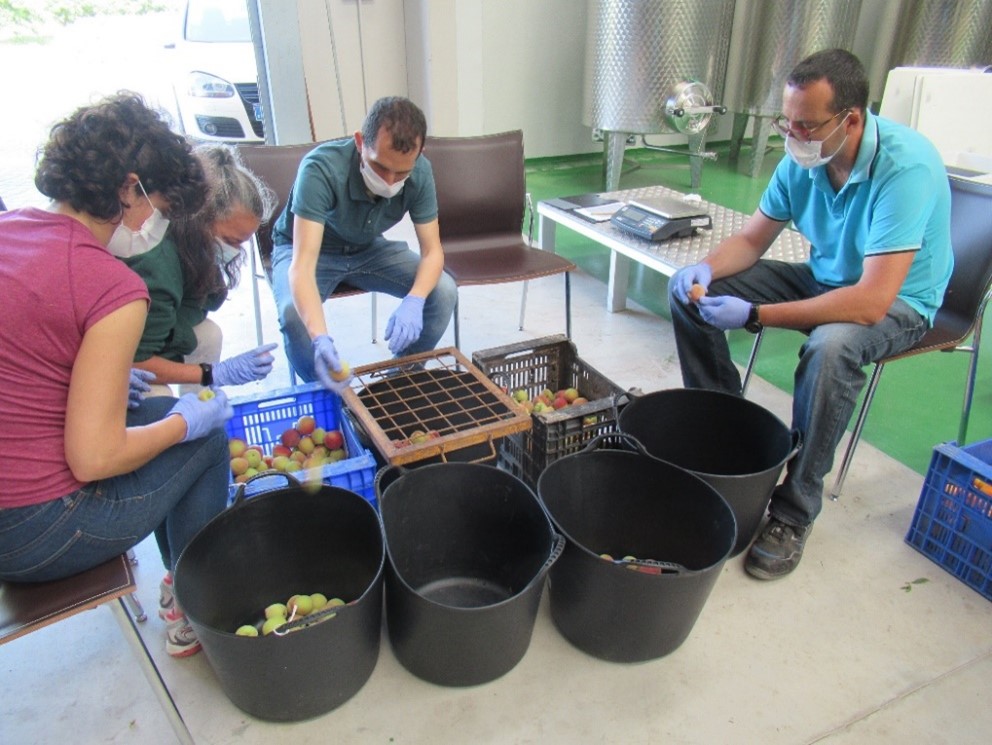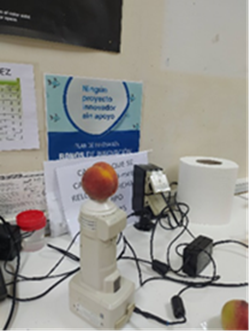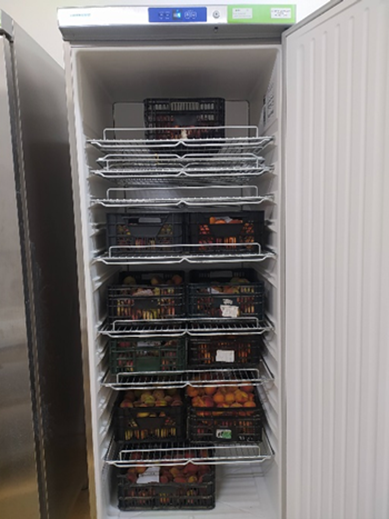B4 Demonstration of effectiveness in the field under actual conditions of use
B.4.1.- Selection of the demonstration plot
The objective is to identify the test plots to demonstrate the efficacy of the formulations in the field, as well as the monitoring of useful agricultural biodiversity, actions that are directly related. The validation of the formulations was carried out in the facilities of the Sinyent experimental farm, owned by AVA-ASAJA.
Two stone fruit growing areas have been selected, one for the evaluation of the efficacy of the new formulations, and the other for biodiversity monitoring. This is due to the fact that, within the same fruit tree species, there are control treatments (chemical pesticides) and experimental treatments (the new biopesticides), so that, from the point of view of biodiversity, a larger area unit is required to improve the significance of the results.

B.4.2.- Application of WASTE4GREEN products
With the aim of validating the use of the new Waste4Green biopesticides in stone fruit crops, a comparison was made with other pesticide and fungicide products with active ingredients of chemical origin, by monitoring pests and diseases, evaluating their effect on nutritional parameters of the fruit trees, and on harvest yields and fruit quality.
The agronomic trials were carried out on plots of peach, flat peach and plum trees, following the following experimental design:
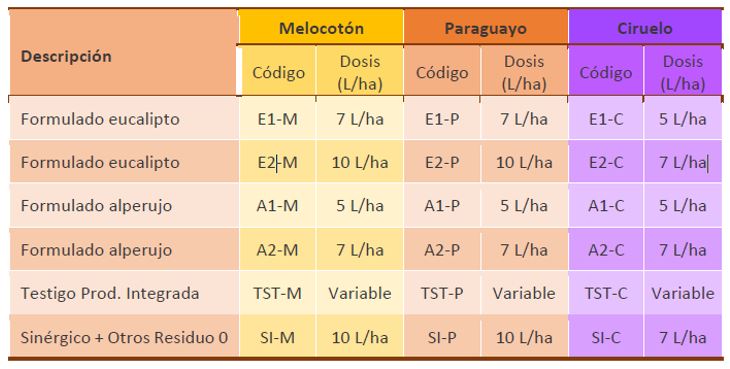
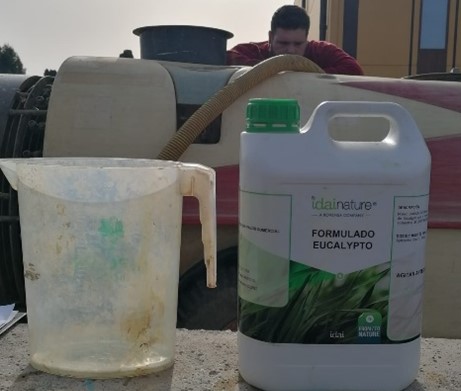
The trials have been carried out in the 2021 and 2022 crop years.
B.4.3.- Crop monitoring: incidence of pests and diseases
The target pests selected during the first crop season were whitefly (Bemisia tabaci), black wood aphid (Pterochloroides persicae), green peach midge (Asymmetrasca decedens) (synonym of Empoasca decedens) and thrips (Frankliniella occidentalis). To sample all these populations simultaneously, chromatic traps were used to determine the population percentage in each of the trial theses. Based on the efficacy results of the first campaign, the aphid was selected as the target pest for the second campaign. The applications were programmed to coincide with the maximum population of the pest in order to evaluate the shock effect of the bioformulation.
In terms of diseases, Taphrina deformans was the one with the highest incidence in both seasons, and the percentage of leaves affected by the fungus was evaluated. The bioformulation was tested to evaluate the curative and preventive effect.
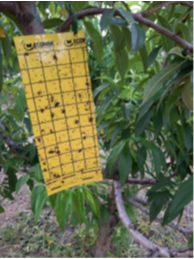
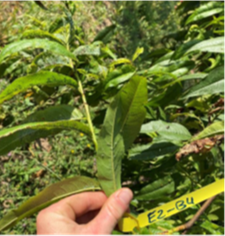
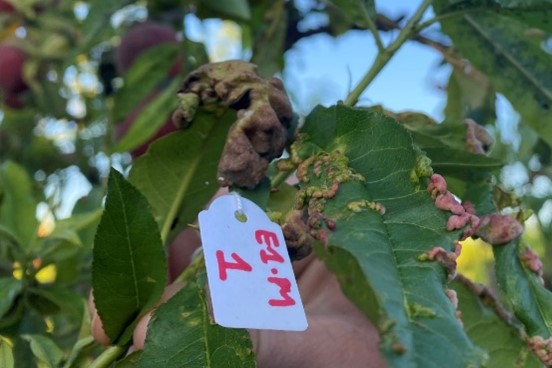
Conclusions
- The high-dose (A2) alperujo formulation applied after two applications against aphids shows an adequate percentage of pest control, although the high-dose (E2) eucalyptus shows a more significant reduction of adults after a first application.
- Taphrina spp. control should be based on preventive treatments at leaf fall and at the beginning of winter. In contrast, spring treatments based on eucalyptus formulated at 10 L/ha on peach trees show a significant reduction in the percentage of symptomatic leaves. Synergistic treatment at 10 L/ha shows effective disease control after two applications.
B.4.4.- Evaluation of the efficacy of WASTE4GREEN products
The conclusions of the validation of the use of the new Waste4Green biopesticides in stone fruit crops are presented below, comparing them with other pesticide and fungicide products with active ingredients of chemical origin, by monitoring pests and diseases, evaluating their effect on nutritional parameters of the fruit trees, and on harvest yields and fruit quality.
In the trial carried out on the peach crop, in the location of the trial and attending only to the 2021 campaign:
1. The application of eucalyptus-based formulations can be effective for the control of black aphids after three treatments, being considered as the main pest of stone fruit trees in the region tested. The same is true for whitefly control, although this pest is less relevant in these crops.
2. The eucalyptus formulation at 10 L/ha shows similar control of green midge to that obtained with conventional products after three applications on peach trees. The same occurs in the control of other cicadellidae present in the field.
3. It is likely that the use of alperujo-based formulations at 5L/ha will show effective control of thrips in peach after the third treatment.
4. Taphrina spp. control should be based on preventive treatments at leaf fall and at the end of winter. In contrast, spring treatments based on eucalyptus formulated at 10 L/ha on peach trees show a significant reduction in the percentage of symptomatic leaves. The synergistic treatment at 10 L/ha shows effective disease control after two applications.
5. At a nutritional level during the crop cycle, and in general, the thesis in which the pomace formulation was applied at 7 L/ha was the one with the highest chlorophyll values, and with optimum levels of micronutrients, while the trees that received a dose of 5 L/ha of this formulation showed, in general, the most suitable values of macronutrients. Overall, the thesis in which the synergy formulation was applied at 10 L/ha was the most nutritionally compensated, taking into account the parameters evaluated.
6. The total productivity (gross yield, kg/ha) of the peach trees on which the eucalyptus formulation was applied at a dose of 7 L/ha, together with the control group of integrated production, was higher than the gross yield of the rest of the theses evaluated. Focusing production exclusively on peaches suitable for consumption, in the trial field where the synergy formulation was applied, the same net yield (kg/ha) was obtained as in the two previous theses.
7. In relation to the rest of the production parameters, the two trial fields in which the eucalyptus formulation was applied obtained peaches with a higher average weight, and together with the trial field in which the 5 L/ha alperujo formulation was applied, also managed to maintain the lowest percentages of green or unripe fruit. On the other hand, the theses in which the alperujo formulation was applied at a higher dose (7 L/ha), the synergy formulation and the conventional chemical products, showed a lower percentage of overripe fruit.
8. In terms of health, in general, all the trial fields showed low percentages of diseased fruit.
9. In the quality parameters evaluated on suitable peach fruit, in general, the thesis in which the alperujo formulation was applied at the lowest dose (5 L/ha) obtained the best results with regard to water-soluble vitamin content, ºBrix and instrumental colour, followed by the two theses in which the eucalyptus formulation was used. On the other hand, the firmness of the peaches was higher in the integrated production control thesis.
10. In the shelf-life test, the peaches from the trial fields treated with the synergy formulation, with the 7 L/ha alperujo formulation and the control thesis in which the post-harvest treatment was carried out, were the ones that showed the longest shelf-life. At the sensory level, the peaches from the trial fields treated with the synergy formulation and the alperujo formulation at a lower dose (5 L/ha) were found to have a better balance between acidity and sweetness, being the best valued in the sensory aspect with the passage of time.
11. In the analysis of pesticide residues:
a. In the agricultural soil samples, across the board, there was a 43.33% decrease in pesticide residues (fungicides and insecticides) in the soil of all peach test fields.
b. In leachate water, across the board, there was a 47.53% decrease in pesticide residues (fungicides and insecticides) in the leachate water of all peach test fields.
c. In the analyses carried out on the acceptable raw material, residues of difenoconazole were only detected in the trial field destined to the lower dose (5 L/ha), although well below the maximum residue limit.
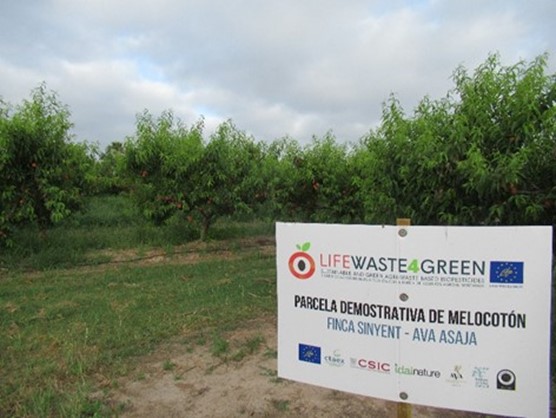
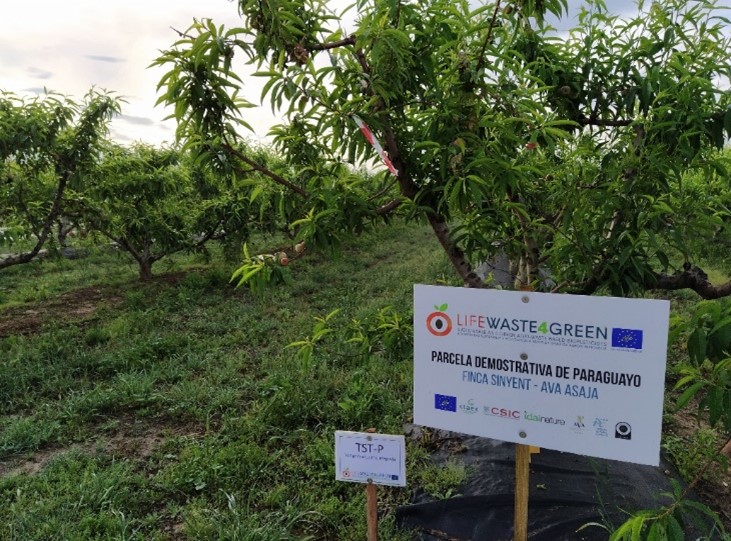
In the trial conducted on the flat peach crop, at the location of the trial and only for the 2021 season:
1. The eucalyptus formulation at 10 L/ha shows a similar control of green midge to that obtained with conventional products after three applications in flat peach crop. The same occurs in the control of other cicadellidae present in the plot.
2. Taphrina spp. control should be based on preventive treatments at leaf fall and at the end of winter. In contrast, spring treatments based on eucalyptus formulated at 10 L/ha on flatwoods show a significant reduction in the percentage of symptomatic leaves. The synergistic treatment at 10 L/ha shows effective disease control after two applications.
3. At the nutritional level during the crop cycle, and in general, the thesis in which the 5 L/ha alperujo formulation was applied showed the highest chlorophyll values, while the trees treated with the 10 L/ha synergy formulation showed the most suitable values of macronutrients, followed by the other thesis treated with the alperujo formulation (7 L/ha).
4. The total productivity (gross yield, kg/ha) of the flat peach trees on which the synergy formulation was applied was higher than the gross yield of the rest of the theses evaluated, followed by the thesis treated with the alperujo formulation at 7 L/ha. Focusing production exclusively on the flatwoods suitable for consumption, the yield values of the two previous theses were inverted, with the thesis treated with the alperujo formulation (7 L/ha) being on this occasion the trial field with the highest net yield (kg/ha).
5. In relation to the rest of the production parameters, the trial field in which the synergic formulation was applied obtained the highest average weight of flat peaches, and together with the control trial field, also managed to maintain the lowest percentages of green or unripe fruit. On the other hand, the thesis in which the alperujo formulation was applied at a higher dose (7 L/ha) showed a lower percentage of overripe fruit.
6. In terms of health, in general, all trial fields showed low percentages of diseased fruit.
7. In the quality parameters evaluated on suitable flat peach fruits, disparate results were obtained. In general, the thesis in which the synergy formulation was applied was the one that obtained the best results with regard to the content of water-soluble vitamins. The ºBrix was higher in the two trial fields treated with the eucalyptus formulation and the 7 L/ha alperujo formulation. With regard to instrumental colour, in general, the 5 L/ha alperujo formulation had the highest values in the brightness and yellow colour coordinates, and the control group of flat peaches showed the highest values in the red colour coordinate. Finally, the firmness of the flat peach fruits was higher in the two theses in which the alperujo formulation was applied.
8. In the shelf-life test, the flat peach in all trial fields had a similar shelf-life (14 days), although in the case of the thesis where the eucalyptus formulation was applied at 10 L/ha, the shelf-life was reduced to 7 days.
9. In the analysis of pesticide residues:
a. In the agricultural soil samples, across the board, there was a 59.85% decrease in pesticide residues (fungicides and insecticides) in the soil of all peach test fields.
b. In the leachate water, across the board, there was a 96.14% decrease of pesticide residues (fungicides and insecticides) in the leachate water of all flat peach test fields.
c. In the analyses carried out on the acceptable raw material, no residues of any active substance were detected in any of the test fields.
|
Chlorophyll measurement with SPAD-502Plus |
Collection of a leaf sample |
Induced Plasma Spectrometer |
In the plum tree crop, at the trial location and only for the 2021 season:
1. At the nutritional level during the crop cycle, and in general, the thesis in which conventional pesticides were applied showed the highest chlorophyll values, while the trees treated with the eucalyptus and alperujo formulated at higher doses (7 L/ha) showed the most suitable values of macronutrients.
2. The total productivity (gross yield, kg/ha) of the plum trees on which the eucalyptus 5 L/ha and the alperujo 7 L/ha formulations were applied was higher than the gross yield of the other theses evaluated, followed by the other two theses treated with these formulations. Focusing production exclusively on plum trees suitable for consumption, the highest net yield values (kg/ha) continued to be found in the 5 L/ha eucalyptus and 7 L/ha alperujo theses.
3. In relation to the rest of the production parameters, the control trial fields, the synergic formulation at 7 L/ha and the eucalyptus formulation at 5 L/ha were the ones with the highest average weights. The alperujo thesis at 7 L/ha managed to maintain the lowest percentages of green or unripe fruit, and together with the other alperujo thesis (5 L/ha) and the eucalyptus thesis at 7 L/ha also showed a lower percentage of overripe fruit.
4. In terms of health, in general, the trial fields in which the eucalyptus formulation was applied at 5 L/ha, the synergy formulation at 7 L/ha and the control showed the lowest percentages of diseased fruit, with the two alperujo theses obtaining the worst results.
5. The plums from the trial fields in which the eucalyptus and alperujo formulations were applied at the lowest doses (5 L/ha) obtained the highest ºBrix values.
|
Manual selection of stone fruit |
Colourimeter used to determine the colour of the fruit |
Fruit in preservation chamber at 5ªC |

